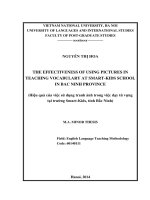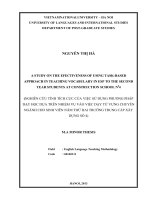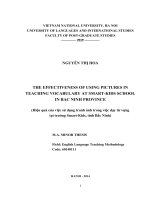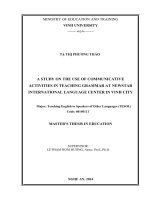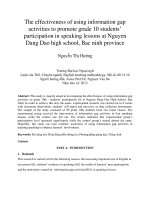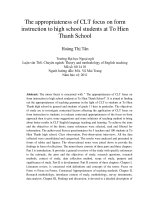The effectiveness of using games as supplementary activities in teaching grammar for junior high school students at Wellspring International Bilingual School Action research
Bạn đang xem bản rút gọn của tài liệu. Xem và tải ngay bản đầy đủ của tài liệu tại đây (172.04 KB, 7 trang )
The effectiveness of using games as
supplementary activities in teaching grammar
for junior high school students at Wellspring
International Bilingual School: Action research
Nguyễn Hồng Nhung
Trường Đại học Ngoại ngữ
Luận văn ThS. Chuyên ngành: English Language Teaching Methodology
Mã số: 60 14 10
Người hướng dẫn: Dr. Ngo Huu Hoang
Năm bảo vệ: 2013
Keywords: Tiếng Anh; Phương pháp giảng dạy; Ngữ pháp; Trò chơi
Content
INTRODUCTION
1. Rationale:
In studying languages in general and studying English in particular, it can be said that
grammar is seemed to be difficult and boring for students. It is thought by students that English
grammar contains complex, difficult, and different rules. Besides, traditionally, many teachers
approach grammar teaching very seriously, making the lesson dull and uninteresting. Therefore,
students usually feel tired and boring in grammar lessons and then they are not motivated to
study. However, as one of language components, grammar is very necessary and nobody can
refuse the importance of learning this skill. According to William Somerset Maugham (The
Summing Up, 1938), “It is necessary to know grammar, and it is better to write grammatically
than not, but it is well to remember that grammar is common speech formulated.” “Grammar is
the structural foundation of our ability to express ourselves. The more we are aware of how it
works, the more we can monitor the meaning and effectiveness of the way we and others use
language. It can help foster precision, detect ambiguity, and exploit the richness of expression
available in English.” Moreover, as stated by McKay (1987), in order to communicate
effectively in English, students need to have a good foundation in grammar. Once again, Ur
(1988) states that a person who knows grammar is one who can express himself or herself in
what would be considered as acceptable language forms. In brief, although grammar plays an
important part in English studying, students do not have motivation in learning this skill.
What are the solutions to solve with the stated matter above? Perhaps, teachers need to
apply variable teaching methods to stimulate students to study so that they can understand and
master grammar as well as feel motivated when studying lessons. There are many ways that help
students be interested in and follow the lessons. In the writer’s position, that games through
lessons is one of the most appropriate approaches. This approach can help students find studying
English grammar more easily. Thus, in the present study, the writer has an intention of proving
that applying games into lessons is also very effective for junior high school students. Moreover,
junior high school students are still at the age of young students; therefore, they prefer do actions
to sit quietly in class. As a result, the writer thinks that games are appropriate for them to
motivate their studying. She also hopes that by using games, the students will not be bored and
they will study English grammar with full of motivation. Although learning grammar is not a
simple work, games encourage students to maintain their interest in learning. And then, they can
attain achievements in four communicative skills.
In this context, the students who took part in this research are rather good at Speaking,
Reading and Listening; however, they often have many difficulties in Writing. They can
communicate with native speakers very well but doing grammar exercises is an obstacle for
them. In fact, most of the students think that grammar is the most boring lesson in English
subject; studying grammar is just to repeat structures, usages for these structures and vocabulary,
and then, practice with exercises. In other words, the students do not have motivation to study
grammar. Consequently, this also causes students’ failure to improve their communicative skills.
In order to solve the obstacle, the author carried out this Action research by applying games as
supplementary activities in teaching grammar in her own class. The writer hopes that the new
teaching method will bring the students a new learning environment in which they can study
with full of their interest, their energy, and their stimulation.
In conclusion, with all of the reasons stated above, the researcher would like to devote
her time and effort researching to her thesis: “The effectiveness of using games as supplementary
activities in teaching grammar for junior high school students at Wellspring International
Bilingual School – Action research”. From this, she expects to help her students motivate as well
as make progress in studying grammar.
2. Aims of the study:
The purpose of this research is to enhance junior high school students at Wellspring International
Bilingual School to study grammar, and then balance grammar learning with other skills learning
(Speaking, Listening, Reading, and Writing). The paper aims to recognize if using games as
supplementary activities increase the students’ motivation in studying grammar.
3. Research questions:
This paper is designed to find out the answers to the following questions:
RQ1: How much does the use of games improve junior high school students’ motivation in
grammar learning at Wellspring International Bilingual School?
RQ2: If so, by what ways does this new teaching method enhance their motivation in grammar
learning?
4. Scope of the study:
As being shown in these research questions above, this study was conducted at
Wellspring International Bilingual School located in Hanoi. This was implemented on fifteen
students of class 789A3. Before the treatment of this action research, they did not have
motivation in grammar lessons and their results also were not good. With the application of
games as supplementary activities in teaching grammar, the teacher – the researcher hoped to
create attractive and effective learning environment for her students so that they could feel
motivated and improve themselves.
5. Practical significance of the study:
This current action research tends to be institutional because it was carried out with a
small group of students in a specific context (only fifteen students in the class 789A3 at
Wellspring International Bilingual School). Thus, the researcher is aware that the results cannot
be easily generalized. She hoped that through the results of this action research, she could help
her own students increase their motivation in studying grammar to improve their learning. And
then, she herself could improve her teaching skills.
6. Methods of the study:
The current action research tended to use qualitative method. Since only fifteen students
in class 789A3 joining in this study, the amount of students was small and the researcher took
notice of every member; therefore, the practitioner employed qualitative approach with the
support of quantitative method.
6.1. Data collection methods:
Data was collected by tests (pre-test and post-test) and the teacher’s diaries. Firstly, the
researcher identified the current learning situation or the students’ problems when dealing with
grammar studying. Next, a system of tests including pre-test and post-test was implemented to
compare the students’ progress in grammar retention. And then, during the treatment, the
teacher’s diaries were written weekly to collect the students’ motivation in grammar learning.
6.2. Data analysis methods:
The collected data was categorized to answer the two research questions. Firstly, the
results of the pre-test and the post-test were compared. From this, the students’ motivation in
grammar learning could be revealed through the improvement of the students’ grammar
retention. After that, all of the researcher’s diaries during the treatment of fifteen weeks were
collected. Then, she calculated the number of participants in each week and demonstrated under
the format of a column chart. By this way, the enhancement of the students’ motivation in
grammar learning could be recognized.
7. Design of the study:
There are three main parts in the study:
Introduction: introduces Rationale, Aims of the study, Research Questions, Scope of the study,
Practical significance of the study, Methods of the study, and Design of the study.
Development: includes three following chapters:
Chapter 1: Literature Review: introduces the theoretical foundations for the whole
study.
Chapter 2: Methodology: elaborates on the setting, the participants, the materials, the
methods used, the instruments, and the data collection procedure.
Chapter 3: Findings and Discussions: introduces the data analysis procedure, presents
and analyses all the data to find out the answers to the two research questions, and then
gives out the summary from the findings.
Conclusion: summarizes all the major points in the study, reveals the limitations of the study
and proposes some suggestions for further studies.
REFERENCES
1. Celce-Murcia, M., & McIntosh, L. (Eds.). (1979). Teaching English as a second or
foreign language. Newyork: Newbury House.
2. Cohen, L., & Manion, L. (1985). Research Methods in Education. London: Croom Helm.
3. Ellis, R. (1994). The Study of Second Language Acquisition. Oxford: OUP.
4. Ersoz, Aydan. (2000) Six Games for the ESL/EFL Classroom. iteslj.org/Lessons/Ersoz-
Games.html.
5. Gülin Yolageldili and Arda Arikan (2011). Effectiveness of Using Games in Teaching
Grammar to Young Learners. Elementary Education Online, 10(1), 219-229, 2011. İlköğretim
Online, 10(1), 219-229, 2011. [Online]:
6. Harmer, J. (1987). Teaching and Learning Grammar. Longman Group UK Ltd.
7. Hedge, T. (2000). Teaching and Learning in the Language Classroom. Oxford: OUP.
8. Nguyễn, Liên Hương. (2005). How to teach grammar communicatively. HCM city: M.A
thesis at the University of Social Sciences and Humanities, Vietnam National University- HCM
City.
9. Ian Hughes (2011). How to keep a research diary. Johnston Press – Fall 2011. ICL
7992.001
10. Kemmis, S., & McTaggart, R. (1982). The action research planner. Victoria, Australia:
Deakin University Press.
11. Kim, L. (1995). Creative Games for the Language Class. Forum, Vol. 33. March1995 at
12. Larsen-Freeman, D. (1986). Techniques and Principles in Language Teaching. Oxford:
Oxford University Press.
13. Lee, W. R. (1979). Language teaching games and contests. Oxford: Oxford University
Press.
14. Lightbown, P., M. & Spada N. (1999). How languages are learned. Oxford: Oxford
University Press.
15. Littlewood, W.T. (1998). Motivation for Learning English”. Foreign and Second
Language Learning. Cambridge: CUP.
16. Lynne Brown (2002). Improving teaching practices through action research. Blacksburg
Virginia: Ph. D dissertation in the Faculty of the Virginia Polytechnic Institute and State University.
17. Maugham, S. W. (1938). The summing up. England: Garden City Publishing Company.
18. McCallum, G. P. (1980). 101 word games: For students of English as a second or foreign
language. Oxford: Oxford University Press.
19. McKay, S. (1987). Teaching Grammar: form, function and technique. United Kingdom:
Prentice Hall.
20. McKay, H. and Tom, A. (1992). What do Adult Learners Bring to a Class? Teaching
Adult Second Language Learners. Cambridge: CUP.
21. Mertens, D. M. (2005). Research and evaluation in education and psychology:
integrating diversity with quantitative, qualitative and mixed methods. United States of America:
Sage Publications, Inc.
22. Mills, G. E. (2003). Action research: A guide for the teacher researcher. Upper Saddle
River, NJ: Merrill/ Prentice Hall.
23. Nedomová, A. (2007). Teaching grammar to young learners. Unpublished master thesis,
Masaryk University, Czech Republic. Retrieved on 28-March-2008, at URL:
24. Khuất, Thị Thu Nga & Nguyễn, Thị Thanh Huyền. (2003). The effectiveness learning
vocabulary through games. Asian EFL Journal Quarterly, 5(4). Available online at
25. Obee, B. (1999). The Grammar Activity Book. Cambridge University Press.
26. Osha Saeed Al Neyadi (2007). The Effects of Using Games to Reinforce Vocabulary
Learning. Action Research and Initial Teacher Education in the UAE. HCT Press.
27. Richard-Amato, P.A. (1996). Making it happen: Interaction in the second language
classroom (2nd ed.).New York: Longman.
28. Rinvolucri, M. (1990). Grammar games: Cognitive, affective and drama activities for
EFL students. Cambridge: Cambridge University Press.
29. Sagor, R. (1992). How to Conduct Collaborative Action Research. Alexandria, VA:
Association of Supervision and Curriculum Development.
30. Saricoban, Arif and Esen Metin. (2000) Songs, Verse and Games for Teaching
Grammar. iteslj.org/Techniques/Saricoban-Songs.html.
31. Smith, M. (2001). Making Content Classes More Communicative. Teacher’s Edition 6.
(p. 14-17).
32. Spolsky, B. (1998). Conditions for Second Language Learning”. Introduction to a
General Theory. Oxford: OUP.
33. Sungurtekin, Ş., Sezer, G. O., Bağçeli-Kahraman, P., & Sadioğlu, Ö. (2009). The views of
pre-service teachers about creative drama: A study according to gender. İlköğretim Online, 8(3),
755-770. Retrieved on 14- January-2010, at URL: http://ilkogretim-
online.org.tr/vol8say3/v8s3m11.pdf
34. Topkaya, E. Z., & Küçük, Ö. (2010). An evaluation of 4th and 5th grade English
language teaching program. İlköğretim Online, 9(1), 52-65. [On-line serial]: Retrieved on 14-
January-2010, at URL:
35. Lưu, Trọng Tuấn & Nguyễn, Thị Minh Đoàn (2010). Teaching English Grammar
through Games. Studies in Literature and Language Vol.1 No.7. Available online at http://
www.cscanada.net
36. Ur, P. (1988). Grammar practice activities: A practical guide for teachers. Cambridge:
Cambridge University Press.
37. Wright, A., Betteridge, D., & Buckby, M. (1984). Games for language learning (2nd
ed.). Cambridge: Cambridge University Press.

